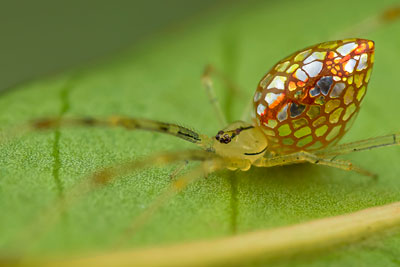Mirror spider “like a disco ball”
God’s amazing creation is full of never-ending surprises

The eye-catching reflective patches on the abdomen of this Thwaitesia spider certainly make it one of the prettier arachnids. “Like a disco ball with lots of different mirrors” is how Queensland Museum spider expert Robert Whyte described it, speculating that the shimmery spots “scatter light and make it difficult for predators to see it.”1
Popularly known as ‘mirror spiders’ or ‘sequined spiders’, Thwaitesia species are relatively little studied as yet. However, in other better-researched spiders which have similar white or silver markings it is known that the causal pigment is guanine (which is also a component of DNA). Unlike the blue/green bilin pigments (e.g. of huntsman spiders) and the red-brown-gold-yellow-purple-black pigments (e.g. of redback spiders), guanine is not a ‘conventional’ pigment as it simply reflects light.
Guanine is a waste product that spiders store in nonhazardous anhydrous crystalline form in specialized cells called guanocytes, immediately beneath the spider’s transparent skin. The crystal form and arrangement determines colour—matt white or silver.2
“Guanine deposits in a spider’s integument are not there by chance and neither are they just the random deposition of unwanted guanine under the cuticle” wrote one spider expert, noting the consistency in placement and form across white/silver spider species.3 What’s more, ‘mirror’ patches are not static but can change in size—within a fraction of a second.
When disturbed—especially when a spider has to drop suddenly from its web—the reflective guanine markings suddenly contract4 or even “disappear more or less completely”.2 Thus the spider rapidly changes colour to something much drabber, more like the colour of its surrounds. It generally takes a few minutes to recover its ‘mirrors’ again. While “it is not clear how this impressive phenomenon works”, in one spider finely striated muscles have been found with guanocytes. Contraction of those muscles might be the cause of rapid diminution of the guanine patches, but this has “yet to be explored”.2
Indeed there is much about God’s amazing creation that is yet to be explored, with many more surprising creatures and their features awaiting man’s discovery and examination. How apt that the Psalmist wrote, “O LORD, how manifold are your works! In wisdom have you made them all; the earth is full of your creatures.” (Psalm 104:24).
References and notes
- Cudmore, B., How is a spider like a disco ball?, sciencefriday.com/articles/picture-of-the-week-sequined-spider, 8 September 2014. Return to text.
- Wunderlin, J., and Kropf, C., Rapid colour change in spiders, Chapter 26 of Nentwig, W. (Ed.), Spider Ecophysiology, Springer-Verlag, Berlin, 2013. Return to text.
- Atkinson, R., Spider hazards and defences, findaspider.org.au/info/hazards.htm, 15 February 2015. Return to text.
- The photographer of the Thwaitesia spider shown here, Nicky Bay, has also photographed the same spider after a disturbance, showing the contraction of the ‘mirrors’. sgmacro.blogspot.com.au/2013/07/transformation-of-mirror-spider.html. Return to text.


Readers’ comments
Comments are automatically closed 14 days after publication.